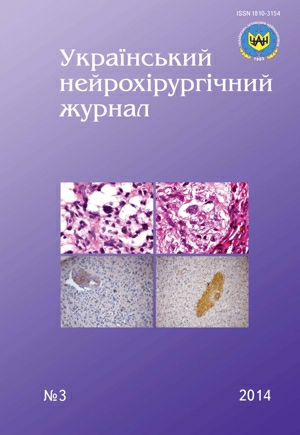Investigation of the cytokine status in patients during the acute period of intracranial arterial aneurysm rupture
DOI:
https://doi.org/10.25305/unj.47495Keywords:
subarachnoid haemorrhage, cerebral vasospasm, interleukin-6, interleukin-1β, interleukin-4Abstract
Objective: Analyze the changes of -1β, -4, -6 interleukin indices in blood serum of patients during the acute period of intracranial arterial aneurysm (AA) rupture.
Materials and methods: Levels of -1β, -4, -6 interleukins in the serum were analyzed in 37 patients during the acute period of intracranial arterial aneurysm (AA) rupture with the help of immune-enzyme analysis: in 27 patients on the 1–4th day since the manifestation of the disease; in 22 patients — on the 7–10th day after the haemorrhage (in 10 — recurrent). Clinical and instrumental examination of all the patients included brain CCT, cerebral angiography, ultrasonography; microsurgical exclusion of aneurysm was carried out according to indications.
Results: The interleukin indices in the serum of patients with SAH were higher than those in the control group mainly on the 7–10th day after the SAH episode.The interleukin-6 level was 20–30 times higher compared to the average index of the control group. There was a reliable increase of its level in patients with cerebral vasospasm (VS) compared to those without VS (p<0,05). The interleukins-1β and -4 indices were moderately (2–5 times) increased in comparison with those in the control group, they did not differ significantly in patients with VS and without it. In patients likely to have grave incapacitation or fatal outcome interleukin-6 levels were significantly higher both during the first 4 days of the disease (p<0,05), and on the 7–10th day.
Conclusions: The increased levels of -1β, -4 та -6 interleukins during the first 10 days after AA rupture indicate that there exist active inflammatory processes in this period of the disease, which gives grounds for the use of antiinflammatory therapy. A connection established between the increase of interleukin-6 level, presence of cerebral VS, as well as severity of the disease may be evidence of this cytokine’s significance in SAH.
References
Bederson JB, Sander Connolly Jr. E, Batjer HH, Daceq RG, Dion JE, Diringer MN, Duldner JE Jr., Harbaugh RE, Patel AB, Roaenwaser RH. Guidelines for the management of aneurysmal subarachnoid hemorrhage. Stroke. 2009;40(3):994-1025. [CrossRef] [PubMed]
Krylov VV., editor. Khirurgiya anevrizm golovnogo mozga [Cerebral aneurysms surgery]. – in 3 volumes. – V1. Moskva: IA. Alekseeva Publ. House; 2011. Russian.
Krylov VV, Gusev SA, Titova GP, Gusev AS. Sosudistyy spazm pri subarakhnoidal'nom krovoizliyanii [Vascular spasm at subarachnoid hemorrhage]. Moscow: Akim; 2001. Russian.
Kolias AG, Sen J, Bell A. Pathogenesis of cerebral vasospasm following aneurysmal subarachnoid hemorrhage: putative mechanisms and novel approaches. J. Neuroscie. Res. 2009;87(1):1-11. [CrossRef] [PubMed]
Pluta R. Dysfunction of nitric oxide syntases as a cause and therapeutic target in delayed cerebral vasospasm after SAH. In: Kiris T, Zhang JH, editors. Cerebral Vasospasm. New Strategies in Research and Treatment. Wien; New York: Springer Verlag; 2008. p.139-147.
Macrez R, Ali C, Toutirais O, Le Mauff B, Defer G, Dirnagl U, Vivien D. Stroke and the immune system: from pathophysiology to new therapeutic strategies. Lancet Neurol. 2011;10(5):471-480. [CrossRef] [PubMed]
Xi G, Keep R, Hoff J. Mechanisms of brain injury after intracerebral haemorrhage. The Lancet Neurology. 2006;5(1):53-63. [CrossRef] [PubMed]
Allan S, Tyrrell P, Rothwell N. Interleukin-1 and neuronal injury. Nat Rev Immunol. 2005;5(8):629-640. [CrossRef] [PubMed]
Dumont AS, Dumont RJ, Chow MM, Lin CL, Calisaneller T, Ley KF, Kassel NF, Lee KS. Cerebral Vasospasm after Subarachnoid Hemorrhage: Putative Role of Inflammation. Neurosurgery. 2003;53(1):123-135. [CrossRef] [PubMed]
Harrod C, Bendok B, Batjer H. Prediction of Cerebral Vasospasm in Patients Presenting with Aneurysmal Subarachnoid Hemorrhage: A Review. Neurosurgery. 2005;56(4):633-654. [CrossRef] [PubMed]
Takizawa T, Tada T, Kitazava K, Tanaka Y, Hongo K, Kameko M, Uemura KI. Inflammatory cytokıne cascade released by leukocytes ın cerebrospınal fluıd after subarachnoid hemorrhage. Neurol. Res. 2001;23(7):724-730. [PubMed]
McMahon CJ, Hopkins S, Vail A, King AT, Smith D, Illingworth KJ, Clark S, Rothwell NJ, Tyrrell PJ. Inflammation as a predictor for delayed cerebral ischemia after aneurismal subarachnoid haemorrhage. Acta Neurochir. 2013;5(6):515-517. [CrossRef] [PubMed]
Muroi C, Hugelshofer M, Seule M, Tastan I, Fujioka M, Mishima K, Keller E. Correlation among systemic inflammatory parameter, occurence of delayed neurological deficits, and outcome after aneurysmal subarachnoid hemorrhage. Neurosurgery. 2013;72(3):367-375. [CrossRef] [PubMed]
Downloads
Published
How to Cite
Issue
Section
License
Copyright (c) 2014 Marina Globa, Nikolay Lisianyi, Orest Tsimeyko, Lyudmila Belska

This work is licensed under a Creative Commons Attribution 4.0 International License.
Ukrainian Neurosurgical Journal abides by the CREATIVE COMMONS copyright rights and permissions for open access journals.
Authors, who are published in this Journal, agree to the following conditions:
1. The authors reserve the right to authorship of the work and pass the first publication right of this work to the Journal under the terms of Creative Commons Attribution License, which allows others to freely distribute the published research with the obligatory reference to the authors of the original work and the first publication of the work in this Journal.
2. The authors have the right to conclude separate supplement agreements that relate to non-exclusive work distribution in the form of which it has been published by the Journal (for example, to upload the work to the online storage of the Journal or publish it as part of a monograph), provided that the reference to the first publication of the work in this Journal is included.









